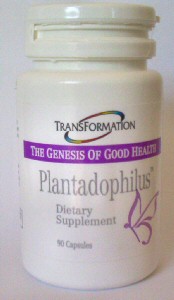$10 GIFT CERT. BY SUBSCRIBING TO NEWSLETTER |

|
|
Probiotics and the Friendly Bacteriaby Dr. Mahamane Mamadou
 "Probiotics" refers to a group of microorganisms that colonize the GI tract, where they live in symbiosis with their host. Within that symbiotic relationship, they provide several benefits to the host, including the synthesis of several important molecules and nutrients as well as the control of potentially pathogenic organisms.
"Probiotics" refers to a group of microorganisms that colonize the GI tract, where they live in symbiosis with their host. Within that symbiotic relationship, they provide several benefits to the host, including the synthesis of several important molecules and nutrients as well as the control of potentially pathogenic organisms.
The human gastrointestinal tract hosts over 400 species of mircroorganisms. Some of these are friendly to the human host as mentioned above, whereas others are potentially harmful, should they be allowed to grow uncontrollably. The organisms most frequently observed (according to Mitsuoka) include Enterococci, Lactobacilli, Clostridia, and Staphylococci. Although the human baby is born with virtually no bacteria in its GI tract, one can find organisms already starting to colonize the GI tract within hours after birth. In fact, some bacteria can even be seen in the feces of most babies within 24 hours after birth. Within 3 or 4 days, the Bifidobacteria start proliferating. The Bifidobacteria proliferation corresponds to a period of relative decrease in the counts of coliforms and putrefactive bacteria. By the end of the first week, Bifidobacteria become the dominant probiotic. The exact source of the Bifidobacteria is not clear. They may come from the mother's vagina, intestinal tract, the birthing environment (even in cases of ceasarian-delivered babies), the nurses, or other factors yet to be determined. However, there does seem to be group specificity, as newborn babies from the same hospital maternity ward seem to have the same type or strain of Bifidobacteria. Following birth and depending on the availability of breast milk, there will be variability in the types and numbers of bacteria in the baby's GI tract. This initial microflora population may influence later metabolic functions in the infant and even on into adult life. Breastfeeding constitutes an important factor in the genesis of the flora. There are several growth factors in human breast milk that appear to promote the viability of the friendly flora and help prevent the proliferation of the potentially pathogenic bacteria.
It is reported that growth, development, and changes in diet result in an ecological variation of the microflora. For instance, during weaning, there is a shift in the ecology of the microflora. Bacteroides, Eubacterium, and Streptococci become more dominant and there is a change from the infant Bifidobacteria to the adult strain of Bifidobacteria. Upon the introduction of adult food to the diet, the most represented bacteria are Bacteroides, Eubacterium, Peptostreptococcus, and Bifidobacteria. These are followed by the Enterococci, Lactobacilli, and Veillonella bacteria. The least represented organisms are yeasts and Staphylococcus. In the elderly (ages 65 to 85), there is a slight increase in the Lactobacilli but a relatively marked decrease in Bifidobacteria. Several factors influence the taxonomy of microflora. Some of these factors include environment, diet, age, medications, health status, and stress level. Microflora taxonomy is also influenced by the species present and their synergistic interactions, along with various other xenobiotics. The human host's goal is to maintain a good balance in the ecology of friendly bacteria, thus allowing hem to effectively control the opportunistic bacteria. One way to keep that balance in optimum condition is to select a diet that supplies the basic nutrients to the enterocytes and the other cells of the body, as well as the probiotics. Thus, a proper diet should include easily digestible food macromolecules necessary for the human host as well as macromolecules that could be used by the probiotics (e.g., fructooligosaccharides - FOS, fruit derived sugar). Many foods that are consumed mostly for the benefits of the probiotics or friendly bacteria are referred to as prebiotics. These are not usually digested by the host, but are digested by the friendly bacteria for their metabolism and their symbiotic relationship with the host. Improper digestion or any improper dietary composition can harm the healthy balance and promote discomfort, the synthesis of harmful molecules, and the growth of the potentially harmful organisms. Various medications (including antibiotics) can also offset the normal balance and destroy the probiotics. It is important to note that any food macromolecule that is not properly digested and its simpler molecules absorbed into the enterocytes could constitute a substrate for the opportunistic microorganisms. The longer the food macromolecules stay in the GI tract, the more fermentation they undergo and the more microbial metabolites may be generated. Some of the metabolites may be beneficial to the host, while other metabolites may be directly harmful to the host. These other metabolites may also be indirectly harmful by killing the friendly bacteria, thus tilting the balance towards the potentially pathogenic organisms. Bacteria and other organisms have a much faster rate of division and can adapt quickly to the environmental conditions in the GI tract. This is very relevant when the dietary composition is poor. Under those conditions, some of the unfriendly bacteria can easily take advantage of the substrates supplied and grow to higher numbers that could be very difficult to bring back into balance. It should also be noted that friendly bacteria do not only control potentially opportunistic pathogens, but they are also involved in regulating host gene expression, which is equally important. Recent studies have indicated that specific friendly bacteria may control the co-lipase gene. Co-lipase is an enzyme involved with assisting pancreatic lipase in hydrolyzing triglycerides in the GI tract. Its absence could render pancreatic lipase less active. This new finding implies that several bacteria may be involved in regulating the expression of other genes within the host. The host genes that are regulated may result in health and homeostasis promotion or, should the bacteria be unfriendly, the result may be the expression of "unfriendly and untimely" molecules that could challenge health and wellness, depending on the type(s) of organisms and their relationship with the host. As several factors can influence the normal population of friendly bacteria, every effort should be taken to optimize their presence, growth, and activity so that their benefits are continually imparted to the host. There are several commercial probiotics and available food sources that could be taken to enhance the health of GI tract flora. However, a careful selection needs to be made. The probiotics consumed must be easily adaptable to the human GI tract and must resist the gastric acidity. Additionally, the probiotics must not eliminate or impede the growth of other friendly bacteria within the host. The synergistic effect among the friendly bacteria is very critical for overall benefits. Once established within the GI tract environment, the probiotics must be able to fulfill their metabolic functions in symbiosis with their host.
Balanced probiotic supplementation and support constitutes good management of GI tract health and could also prevent other diseases beyond the digestive system. The common benefits of friendly bacteria include the following.
· digestion of some of the food macromolecules and enhanced absorption of nutrients
|
 Contrary to the benefits of breast milk, infant formulas do not appear to contain these growth factors. Breast-fed babies have fewer putrefactive bacteria and the stool is usually light yellow with only a slight odor. However, formula-fed babies tend to have higher counts of putrefactive bacteria, resulting in stools with yellowish-brown color and strong odor. Acidic pH is more favorable to Bifidobacteria and inhibitory to putrefactive bacteria. The stool pH of breast-fed babies is in the range of 4.5 to 5.5 and the pH of formula-fed babies is 5.7 to 6.7 (i.e., more neutral).
Contrary to the benefits of breast milk, infant formulas do not appear to contain these growth factors. Breast-fed babies have fewer putrefactive bacteria and the stool is usually light yellow with only a slight odor. However, formula-fed babies tend to have higher counts of putrefactive bacteria, resulting in stools with yellowish-brown color and strong odor. Acidic pH is more favorable to Bifidobacteria and inhibitory to putrefactive bacteria. The stool pH of breast-fed babies is in the range of 4.5 to 5.5 and the pH of formula-fed babies is 5.7 to 6.7 (i.e., more neutral).
 Another important factor in probiotic selection and
Another important factor in probiotic selection and